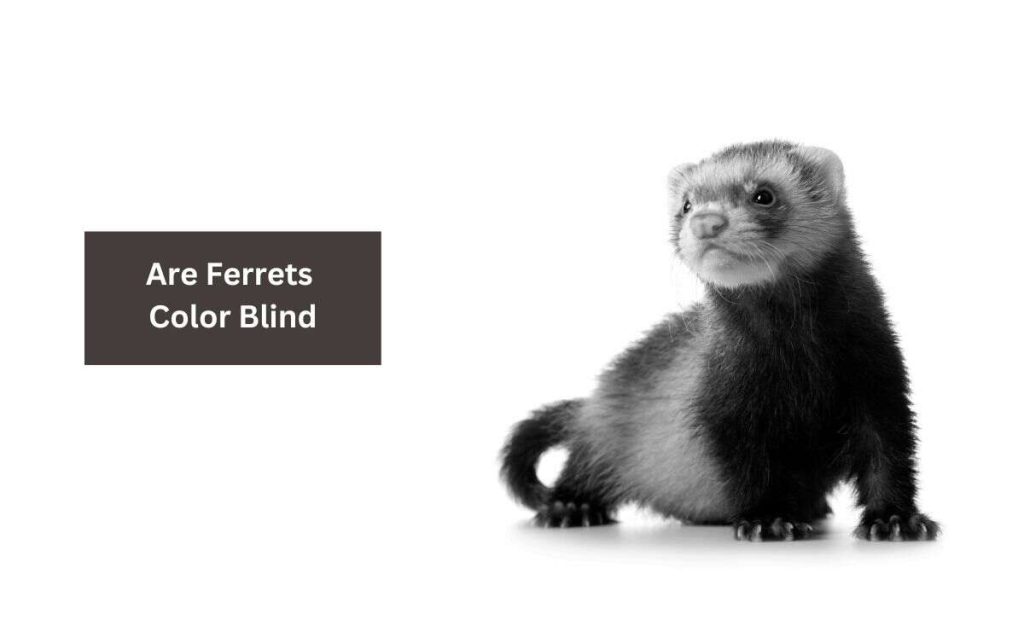Ferrets make awesome pets due to their playful nature. If you are a ferret owner, you might be wondering whether s/he can see you or not.
So, are ferrets color blind? In short, ferrets are not color blind. They can see colors, but their eyes work differently. It is said that they can essentially see shades of red, blue, green, and yellow. But ferrets have very poor eyesight compared to other pets.
Let’s go into the enchanting realm of ferret eyesight and find out how they see the world.
Are Ferrets Color Blind: The Basics Of Their Vision

While ferrets don’t have trouble distinguishing between hues, their eyesight is quite poor compared to other pet animals. Ferrets’ light-sensitive retina has both rods and cones. That said, while ferrets do have some color vision, it is not as developed as ours.
Ferrets have ‘binocular’ or ‘stereoscopic’ vision, which means their eyes are set farther to the sides of their heads than human eyes.
In proportion to their bodies, ferrets have tiny eyes. As a result, they rely heavily on their other senses, especially scent and touch. However, due to their stereoscopic vision, they can see more of their surroundings.
So, they are better able to notice danger or prey. But it highly reduces their ability to judge depth.
Do Ferrets Have Good Eyesight?
We can’t say that ferrets have anything extraordinary when it comes to their eyesight. Their eyesight is less focused on detail. But they can detect motion even in dim lighting which keeps them alert.
Their depth perception is also impaired because of their nearsightedness. However, their poor eyesight is not a problem as they have an acute sense of smell and keen whiskers that allow them to get around just fine.
What Does Ferret Vision Look Like?
As we mentioned, ferrets can see particular colors like shades of red, blue, green, and yellow. So, they are not color blind but their visionary range is narrow. It’s like looking at the world through a filter that dulls the colors.
Due to their eye anatomy and sensory characteristics, ferrets have fairly limited distant vision. Their eyes aren’t designed to view distant objects clearly. So, their vision is best suited for close and intermediate ranges.
For both hunting and exploring, ferrets rely heavily on their keen ability to sense movement. Movement or things beyond a few feet in distance are less likely to catch their attention than those closer at hand.
Can Ferrets See In The Dark?
Although they are not real night-vision animals like some other nocturnal animals, ferrets do have pretty strong night vision and can see in low-light circumstances. More of the light- and motion-sensitive rod cells are found in the retinas of their eyes. Here are a few reasons why Ferrets can see well in the dark:
- Rod Cells: Ferrets’ retinas contain a higher concentration of rod cells than cone cells. Rod cells are essential for night vision because they are optimized for detecting motion and shapes in dim light.
- The Tapetum Lucidum: This is a reflective layer located beneath the retina that provides ferrets with excellent night vision. The layer acts as a mirror, reflecting light back into the retina where the rod cells may pick it up again. As a result, ferrets can see well even if the light is out or dimmed.
- Crepuscular Lifestyle: Ferrets are nocturnal creatures. This means that they are most active at times of low light, such as dawn and twilight. Because of this, they are able to hunt and explore in the dark.
Ferret Vision Vs. Human Vision
Because of the contrasts between ferret and human eyesight, ferrets perceive humans differently than we do. Now we will share what makes them both different.
Perception Of Color
Ferrets can only distinguish between very basic tones of blue and green. But we have three different types of cone cells in our retinas, which are sensitive to color. So we can clearly see and distinguish more colors than ferrets.
Detection Of Movement
The ability to detect movement is crucial to the ferret’s success in the wild, but it is not the same for humans. So, while they have a keen eye for motion, humans may not be able to sense motion to that extent.
Clarity Of Sight
The nearsightedness of ferrets makes it difficult for them to focus on faraway objects. But our complicated eyesight makes it possible for us to view everything clearly.
Dark Vision
The huge concentration of rod cells in the retinas of ferrets allows them to see clearly even in the dark. But humans don’t have that kind of night vision like ferrets do.
Frequently Asked Questions (FAQs)
Can ferrets see red light?
Red light, more especially light in the 635 nm range, is visible to ferrets. They can also see tones of gray, red, blue, and yellow.
Do ferrets like light or dark?
Because of their crepuscular lifestyle, ferrets are night-time sleepers. Their health might be significantly impacted by an absence of darkness and excessive exposure to artificial light.
Are ferrets nocturnal?
Not exclusively nocturnal, ferrets are most active just before and just after sunrise and sunset. They are capable of adapting to the daily schedules of their owners. But too much artificial light may harm their health.
How do ferrets see humans?
The eyesight of ferrets is poor, especially at distances of more than a few feet. Their excellent sense of smell comes in handy in these situations, as they have better close-range vision and a blind spot just in front of their noses.
Wrapping Up
The above discussion may have resolved your confusion about whether are ferrets color blind or not. So, your ferret can see you, but not as much as you can see him/her. However, their incredible sense of motion makes up for this weakness.
So, if you think that your ferret won’t be able to recognize you, that won’t be the case at all. These adorable pets always know their owners and show very playful attitudes.
